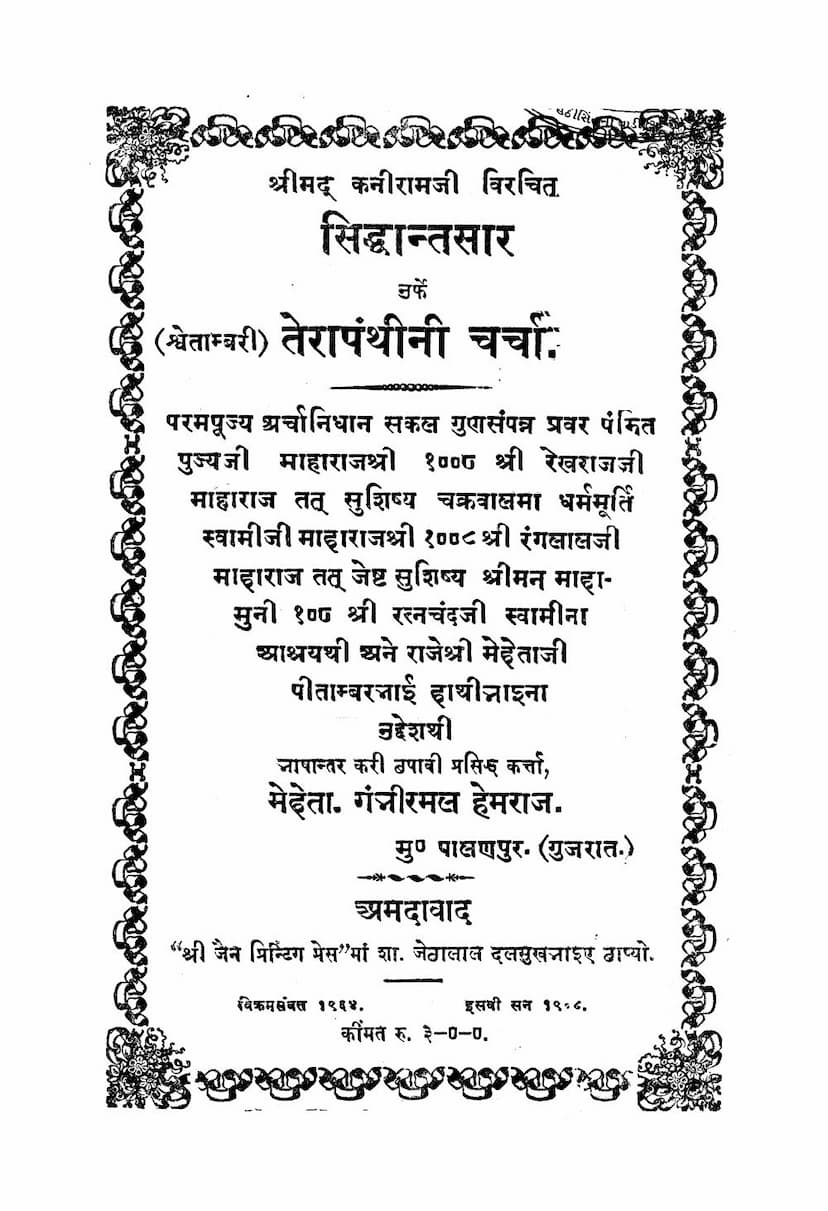Siddhant Sar
Added to library: September 2, 2025

Summary
Siddhant Sar: A Comprehensive Summary
"Siddhant Sar" (Essence of Principles), authored by Gambhirmal Hemraj Mehta, is a significant Jain text that delves into the philosophical and practical aspects of Jainism, particularly from the perspective of the Shvetambara Terapanthi tradition. The book, published in 1908, aims to clarify and defend Jain principles against what it perceives as deviations or misunderstandings, primarily focusing on refuting the doctrines of the Terapanthi sect.
The text begins with an "Arpan Patrika" (Dedication) and an "Udbodh" (Introduction), followed by a detailed "Prastavana" (Preface). The main body of the book is structured as a discourse, often in a question-and-answer format, addressing various points of contention, primarily concerning the origin and tenets of the Terapanthi sect, which emerged in the 18th century CE.
Key Themes and Content:
-
Origin of the Terapanthi Sect: The book traces the genesis of the Terapanthi sect to a muni named Nikhunji in the late 18th century CE. It details how Nikhunji, after studying Jain scriptures, developed interpretations that the author of "Siddhant Sar" considers to be against the true teachings of Jainism. These misinterpretations are presented as the foundation of the Terapanthi sect's unique doctrines.
-
Critique of Terapanthi Doctrines: "Siddhant Sar" systematically analyzes and critiques several core beliefs of the Terapanthi sect. The author contrasts these with what he presents as the orthodox or original Jain teachings. The critical points often revolve around:
- The Nature of Compassion and Charity (Anukampa and Daana): The text argues against the Terapanthi view that acts of compassion, such as feeding the hungry, saving animals, or offering charity, are strictly prohibited or inherently sinful if they involve any form of violence or harm to sentient beings, even at the microscopic level. "Siddhant Sar" defends the Jain principle of compassion as essential and nuanced, allowing for acts of kindness and charity within the framework of righteousness.
- The Role of Scriptures and Interpretation: The book emphasizes the importance of correct scriptural understanding, often accusing the Terapanthis of misinterpreting or misapplying Jain scriptures to justify their own views. It stresses the need for adherence to the original teachings of the Jinas and the established traditions.
- Distinction between Ritual and True Practice: The author often highlights the difference between outward actions and the underlying intention and understanding. While Terapanthis might focus on strict adherence to certain rules, "Siddhant Sar" emphasizes the spirit and deeper principles behind those rules, particularly concerning compassion and ethical conduct.
- The Concept of Aagman vs. Nitgaman: The text frequently discusses the difference between adhering to the original, established scriptures (Aagman) and deviating from them or creating new interpretations (Nitgaman). "Siddhant Sar" positions itself as upholding the Aagman.
-
Defense of Jain Orthodoxy: Throughout the book, the author aims to demonstrate the validity and superiority of the traditional Jain path, highlighting its emphasis on universal compassion, the correct understanding of karma, and the path to liberation as taught by the Jinas.
-
Philosophical Underpinnings: The book likely touches upon fundamental Jain concepts such as:
- Anekantavada (Many-sidedness of Reality): While not explicitly detailed in the provided text, the author's critique of the Terapanthi's perceived rigid interpretations suggests an underlying defense of the nuanced and multi-dimensional approach to reality central to Jain philosophy.
- Karma Theory: The text implicitly engages with the theory of karma, arguing that compassion and righteous acts lead to positive karmic outcomes, while misinterpretations and rigid exclusions lead to negative ones.
- The Path to Liberation (Moksha): The ultimate aim of Jain practice is liberation, and "Siddhant Sar" presents its understanding of the path as the correct way to achieve this goal.
Structure and Language:
The book is written in Gujarati, as indicated by the title page and the initial pages. The preface and introductory sections set the context, explaining the purpose of the book in addressing perceived doctrinal issues. The main content is argumentative, refuting specific points of contention. The author, Gambhirmal Hemraj Mehta, is dedicated to the Jain tradition, and the text reflects a deep commitment to scriptural authority and traditional understanding.
Overall Significance:
"Siddhant Sar" serves as a historical document illustrating an internal theological debate within Jainism during the early 20th century. It highlights the intellectual engagement and efforts to maintain doctrinal purity and continuity within the Shvetambara tradition, particularly in response to emerging sects or interpretations that challenged established norms. The book is valuable for understanding the historical development of Jain sects and the hermeneutical approaches employed within the tradition.
This summary is based on the provided text and the catalog link, focusing on the core themes and arguments presented in the initial pages and the table of contents. A full understanding would require a detailed reading of the entire text.